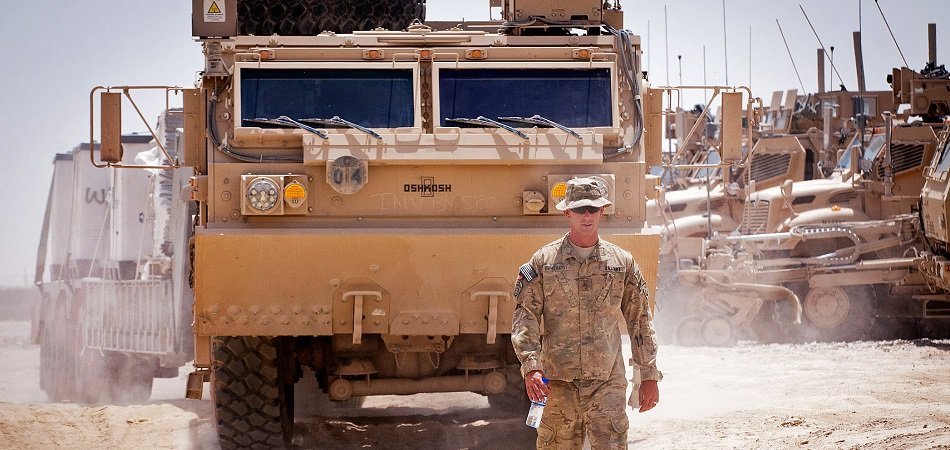
Logistics in the military encompasses more functions than most people realize. In modern warfare, that means large quantities of data to sift through in order to make decisions regarding supply, transport, communications, and so on. Using artificial intelligence (AI) and machine learning (ML) in one or more areas in logistics could help speed up that process and make it more agile.
Although AI and ML could have great benefits for military logistics, the military has focused on AI and ML applications in other areas. The military has been slow on the uptake, and it often accepts an amber status for its logistics in active war zones.
However, integrating AI for logistics in the military comes with its attendant concerns, although they are not the same as those when using AI for surveillance, intelligence, or weapons. The issues with AI for logistics have to do with inherent unpredictability and vulnerability to exploitation.
Data scientists and engineers are making great progress in AI and ML with impressive results, but it is far from foolproof. This lack of certainty has until recently prevented more enthusiastic employment of available AI and ML solutions. A directive requiring all AI-based systems to have a human overseer or operator at all times should mitigate, but not eliminate, the specter of compromised and dangerous technology.
That said, the fact that the biggest adversaries of the US are aggressively pursuing the use of AI and ML in their own defense systems, and that these same systems face the same risks and vulnerabilities, might present unique opportunities for the Department of Defense (DoD) to level the playing field, so to speak.
Be that as it may, the DoD is addressing the issue of using AI for logistics in the US military, spearheaded by the newly formed Joint Artificial Intelligence Center (JAIC). The authors of the “Summary Of The 2018 Department Of Defense Artificial Intelligence Strategy” point out that “Other nations, particularly China and Russia, are making significant investments in AI for military purposes…The United States, together with its allies and partners, must adopt AI to maintain its strategic position, prevail on future battlefields, and safeguard this order.”
This article will run through some of the areas in logistics where AI is either in pilot mode or in active operation. The areas for discussion will include:
- Preventive maintenance
- Cloud services
- Supply chain management
- Medical aid
- Driverless resupply
We begin our analysis with a discussion of preventative maintenance.
Preventive Maintenance
JAIC director Air Force Lt. Gen. John N.T. “Jack” Shanahan stated, “we want to identify some smart automation initiatives that could provide near-term dividends in terms of increased efficiencies and effectiveness for back-office functions.” One important AI logistic initiative under JAIC is preventive maintenance, particularly for fighter jets.
An early version of automated preventive maintenance for the military was the F-35 fighter jet test performed by Lockheed Martin back in 2015. Below is a 2:50-minute video showing the Autonomic Logistics Information System (ALIS) at work:
There is no mention of AI or ML, but Air Force Chief Scientist Gregory Zacharias confirmed AI is the driving force behind the “smart” system. The system will probably get a lot “smarter,” probably with supportive AI software from defense contractor C3.ai. The AI company currently has nine projects with the DoD.
The military uses ALIS and, potentially, the C3 AI Suite for aircraft. However, if the pilot programs prove successful in the long term, the military might easily customize these and similar technologies to accrue the same benefits for other types of vehicles and equipment. We recently posted a more in-depth article on predictive analytics in the military for these other uses.
Cloud Services
A central repository of information might sound like a bad idea for the military, but in the world of logistics, it is necessary. It means savings in time, effort, and money if logisticians have all the information they need to make informed decisions when moving supplies and equipment to support troops.
In line with this, the Army contracted IBM to provide cloud services as well as access to Watson to store and process logistics data coming from various sources. Logistics Support Activity, or LOGSA, (now Logistics Data Analysis Center or LDCA) Commander John Kuenzli stated in 2017:
Capabilities like Watson make it a very exciting time for us. This can be a way to free up our analysts from some of the more technical work, to let the machine do some of that and to leverage the analysts’ professional expertise to look up and look further toward where the Army is going.
The idea is to use the cloud to upload sensor data from vehicles and equipment and perform “conditioned-based maintenance (CBM),” which is a repair-when-needed approach, made possible with AI-driven data analysis. Below is a 4-minute proof of concept video on 360 Stryker combat vehicles from IBM:
While the idea of CBM falls under preventive maintenance, the bigger picture in this particular use of AI is in the move of military data into the cloud. According to DoD Chief Information officer Dana Deasy, data access is the key to effective warfare today. He explained:
One of the things traditional computing has always had a problem with is the warfighter sitting out on the tactical edge, [with the] cloud sitting [elsewhere]. Now imagine a world where we can take that compute power with new applications on top of it, and put the cloud right into the hands of the tactical fighter on the edge. That’s why the cloud is so important to us.
In 2019, that early initiative has bloomed into a multi-billion single-provider contract for secure cloud storage and software under the Joint Enterprise Defense Infrastructure (JEDI) with several commercial companies vying for it. Unfortunately, legal problems are keeping the DoD from going forward with it.
Supply Chain Management
The government can also become a victim of fraud as much as any civilian, and perhaps more so because of the sheer volume of its acquisitions worth about $350 billion a year. For the Defense Logistics Agency (DLA), this is a big problem, as it provides what the military needs, such as weapons, repair parts, and fuel, as well as disposes of surplus equipment. As the DLA receives an average of a million bids a day, it can be fatally easy for some questionable transactions to get through.
To address this issue, the DLA turned to AI and ML software to sort through the mountain of private and public data to identify and flag suspicious or anomalous suppliers. DLA Logistics Operations Vice Director Michael Scott claimed its Business Decision Analytics (BDA) tool has made a big difference. In 5 months of operations:
It has identified more than 350 high-risk CAGE codes or supplier entities. It’s probably one of our top concerns right now from a process perspective is the rise in the number of fraudulent or bad actor companies who are trying to get into our business. This new tool has been very helpful in identifying that from the onset and allowing us to put controls in our systems to not allow them to get business from DLA.
It is unclear if the DLA developed the BDA tool in-house or contracted it out to one of several infotech and AI companies awarded contracts under the J6 Enterprise Technology Services (JETS) program.
Medical Aid
Immediate medical aid is not always available on the battlefield. It may be a lack of actual medics in the area, injuries beyond the skills of a medic, or a matter of triage, where medical personnel prioritize the most badly injured. AI might possibly provide some answers in that area of logistics.
AI in medicine is a well-established field in the commercial sector, but not so much in the military. Efforts are underway to correct this imbalance, with the Army’s Telemedicine & Advanced Technology Research Center (TATRC) heading the charge.
The TATRC recently awarded Charles River Analytics with a contract to develop an AI system that would monitor, diagnose, and treat victims of traumatic injury in the battlefield. Dubbed the Automated Ruggedized Combat Casualty Care (ARC3) system, it will not be a fully automated medical AI, but rather software that can help medics in diagnosing injuries, monitoring patients, and providing treatment when immediate evacuation of the patient is not possible. The system is currently under development.
Charles River also snagged a contract to develop the Ensemble Prediction for Combat Casualty Care (EPIC3) mobile app. The idea is to provide the medic with some decision support when it comes to handling traumatic injury.
In its award, Charles River stated it “uses an ensemble of classifiers, frequently tuned via machine learning to predict life-threatening and difficult-to-detect injuries. EPIC3 purportedly presents the steps to treat those injuries through a simple, easy-to-use interface that tailors itself to the needs and skill level of the user.” This software is under development as well.
AthenaGTX claimed it is in its final stages of based development for its Automated Critical Care System (ACCS). The company described it as a “system of systems” that “integrate patient physiological monitoring with interventions controlled by software algorithms to provide automatic medical care of critically injured warfighters.” Below is a 49-second video of what it will look like:
The company also has a wearable device it claimed could help in battlefield triage. Called the Wireless Vital Signs Monitor (WVSM), it records the vitals of a patient and transmits it to compatible devices. There is no record that either of these products were developed under funding from the military, however.
Driverless Resupply
Drones are making a lot of noise in the AI space, but mostly for surveillance. What most people probably do not realize is that the military is looking seriously at self-driving vehicles to resupply outposts and bases under the Autonomous Ground Resupply program. This would spare human drivers from the hardships and risks of a supply convoy.
The army already awarded a multimillion-dollar contract to Robotic Research LLC to develop autonomous kits. Below are two short videos showing what a driverless supply would look like:
However, sometimes it is better to go as the crow flies, and the Army Research Laboratory is also looking into using aerial drones instead of land vehicles under the Joint Tactical Aerial Resupply Vehicle (JTARV). Of course, the loads would have to be much less, but it could get to places quicker than a ground vehicle could.
To this end, the military is working with Malloy Aeronautics to use its quadcopter (“hoverbike”) as the first JTARV. The ideal JTARV would be able to carry up to 800 pounds, go as fast as 60 mph, and for up to 125 miles. Below is a 4:25-minute video showing the capabilities of the US Military Hoverbike Prototype 2017.
As researchers acquire a better understanding of how AI and ML work, the use case of AI for logistics may become more robust. Until then, the military could still reap the benefits of AI and ML if it ensures the security and safety of its software and data.
Header Image Credit: Department of Defense







